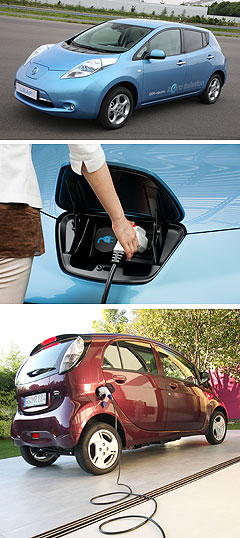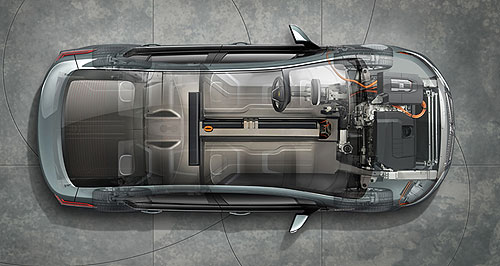Make / Model Search
News - General News - Electric VehiclesCalifornia mandates EV boomRules of the road: Cars like the Chevy Volt will have to account for almost one in six cars sold in at least 10 US states by 2025. Almost one in six new light vehicles sold in California to be zero-emissions by 202530 Jan 2012 CALIFORNIA has continued its tradition of introducing some of the world’s most aggressively ‘green’ vehicle laws by mandating that zero-emissions vehicles account for close to one-sixth of all new light vehicles sold in the state by almost all car-makers by 2025. Just as most manufacturers had begun to come to terms with North America’s strict new Corporate Average Fuel Economy (CAFE) standards, the progressive US state last week passed legislation requiring full-electric, plug-in hybrid and fuel cell vehicles to comprise an increasing proportion of light-vehicle sales from 2018. California, North America’s biggest car and light truck market, has called for 15.4 per cent of light vehicles sold by car-makers accounting for about 97 per cent of new light-vehicle sales – the equivalent of about 1.4 million vehicles, or 40 times the number sold between 1996 and 2010 – to be zero-emissions capable by 2025. The ambitious new emissions reduction legislation, which is supported by major car-makers and expected to be adopted by at least 10 other US states, is part of a broader suite of new vehicle regulations dubbed the Advanced Clean Car (ACC) program. Connecticut, Maine, Maryland, Massachusetts, New York, New Jersey, New Mexico, Rhode Island and Vermont will also adopt the Californian standard, at least doubling the impact of California’s program to annual sales of more than three million zero-emissions vehicles. California accounted for 9.7 per cent of new-vehicle sales in the US in 2010, when all 11 states together accounted for 28.5 per cent of the nation’s 11.4 million sales. Designed to encourage car-makers to develop and sell more vehicles that do not emit exhaust gases, the legislation represents a tough new extension to the state’s zero-emissions vehicle mandate, which has been in place since 1990.  California has led other US states on tougher vehicle emissions laws since 1970, including the addition of catalytic converters and exhaust-treatment systems as standard equipment on all cars sold in the US. California has led other US states on tougher vehicle emissions laws since 1970, including the addition of catalytic converters and exhaust-treatment systems as standard equipment on all cars sold in the US.From 2018, the requirements that currently apply to the six largest car-makers – all from the US and Japan – will widen to encompass the top 12, including Germany’s Volkswagen, Mercedes-Benz and BMW, Korea’s Hyundai and Kia, and Japan’s Mazda. California’s wider emissions mandate, which can impose fines and even restrictions on sales to car-makers that do not comply, comes on top of the biggest increase in CAFE standards in US history. Last year the Obama administration announced plans to double the CAFE standard to 54.5 miles per gallon between the 2017 and 2025 model years. Car companies can generate credits towards the California standard if they exceed greenhouse emission requirements on the federal level. GM, Ford, Chrysler, Toyota, Nissan and Honda must sell a combined 60,000 plug-in or fuel cell vehicles in California between the 2012 and 2014 model years to comply with current state legislation. Legislators say the new laws – which were supported by testimony last week from General Motors, Ford, Chrysler, Nissan and other makers – will reduce smog-forming emissions by 75 per cent by 2025, and CO2 emissions from passenger vehicles by 34 per cent between 2015 and 2025. The plan was voted for unanimously by the California Air Resources Board, which said the ambitious goals could have been even greater and would be supported by subsidies for buyers of zero-emissions vehicles. “That’s actually a relatively modest goal, but that’s all that we’re mandating,” California Air Resources Board chair Mary Nichols told Automotive News. “We expect to go beyond that with other incentives we are hoping to be able to offer in terms of direct incentives to people who buy these cars (such as) rebates and credits.” The Californian mandate includes traditional electric vehicles like Mitsubishi’s i-MiEV (which became Australia’s first mass-production EV last August and is now available here in limited numbers priced from $48,800) and Nissan’s larger Leaf hatchback (which arrives in local showrooms in June from $51,500). Apart from more advanced fuel cell vehicles – such as those promised by 2015 by various car-makers including Toyota, Hyundai and Mercedes-Benz – the Californian mandate also includes plug-in hybrid (PHEV) vehicles like the Chevrolet Volt, which arrives in Australia late this year, and the Toyota Prius Plug-In, which is yet to be confirmed for local release. Ford will also introduce five electrified vehicles in the US this year, including the Focus Electric and the plug-in hybrid C-Max people-mover. Both the Volt and Prius PHEVs are already available in the US, where – as in Japan and many European countries – a number of incentives are offered to buyers of low-emissions vehicles. In Australia, where no such subsidies exist and the vast majority of electricity comes from coal-fired power stations, just 49 EVs were sold last year in a market that topped one million sales for the fourth time, representing a market share of 0.005 per cent. Sales of traditional hybrids like the Toyota Prius, Camry Hybrid and Honda Insight, which are not part of California’s latest vehicle emissions mandate, fell by 9.9 per cent to comprise just 0.87 per cent of all vehicle sales in Australia last year. Nissan once famously predicted that EVs would account for 10 per cent of global vehicles sales by 2020, but some industry groups in the US say car-makers and Californian legislators have overestimated consumer demand. “We think it’s a disconnect with the marketplace,” a spokeswoman for the Alliance of Automobile Manufacturers, Gloria Bergquist, told Automotive News. “Auto-makers have invested literally billions of dollars in these technologies, so we have a real stake in trying to sell as many as possible. But no-one knows what that number is going to be and it doesn’t help anyone if those cars sit on lots unsold.” The latest Californian legislation will require almost one in six light vehicles sold in the state to be zero-emissions capable, putting it on target to achieve its goal for electric or fuel cell vehicles to account for some 87 percent of sales by 2050. CARB says the latest targets would put the state on pace to meet that goal. As part of its renewed green-vehicle push, California will also support the development of hydrogen refuelling infrastructure across the state, in a move that echoes that of Britain. Earlier this month the UK declared its intention to be a key player in a hydrogen future by announcing a new government-backed program to support the roll-out of fuel cell electric vehicles in 2014/15. Dubbed ‘UK H²Mobility’, a total government investment of £400 million ($A594m) will not only offer plug-in car buyers 25 per cent of the purchase price – up to 5000 ($A7420) – but a rebate of 20 per cent (up to 8000) on a plug-in van.  Read more19th of January 2012  Britain backs hydrogenUK government announces fuel cell program and extension of plug-in EV rebate scheme6th of January 2012  GM damps Volt fire furorChev Volt gets more battery protection and leak sensor to fend off fiery fluid leaks20th of December 2011  Nissan Australia prices Leaf at $51,500Ground-breaking new Leaf priced from under $52k as Nissan Oz prepares EV rollout |
Click to shareGeneral News articlesResearch General News Motor industry news |











Facebook Twitter Instagram